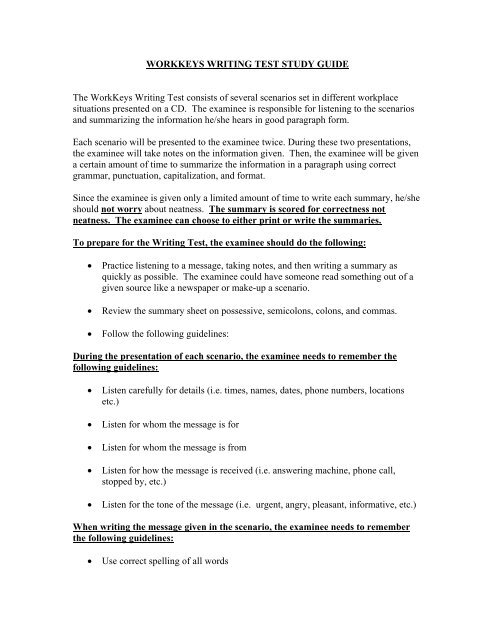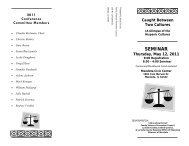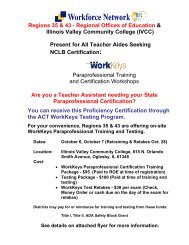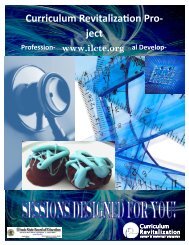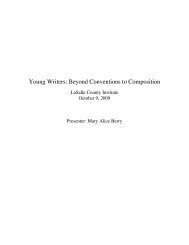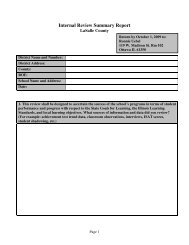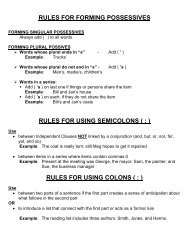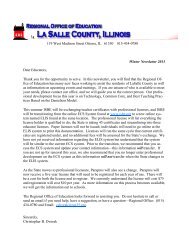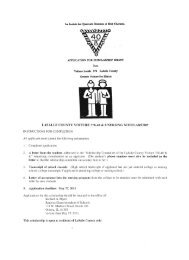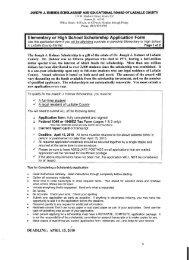WORKKEYS WRITING TEST STUDY GUIDE
WORKKEYS WRITING TEST STUDY GUIDE
WORKKEYS WRITING TEST STUDY GUIDE
You also want an ePaper? Increase the reach of your titles
YUMPU automatically turns print PDFs into web optimized ePapers that Google loves.
<strong>WORKKEYS</strong> <strong>WRITING</strong> <strong>TEST</strong> <strong>STUDY</strong> <strong>GUIDE</strong><br />
The WorkKeys Writing Test consists of several scenarios set in different workplace<br />
situations presented on a CD. The examinee is responsible for listening to the scenarios<br />
and summarizing the information he/she hears in good paragraph form.<br />
Each scenario will be presented to the examinee twice. During these two presentations,<br />
the examinee will take notes on the information given. Then, the examinee will be given<br />
a certain amount of time to summarize the information in a paragraph using correct<br />
grammar, punctuation, capitalization, and format.<br />
Since the examinee is given only a limited amount of time to write each summary, he/she<br />
should not worry about neatness. The summary is scored for correctness not<br />
neatness. The examinee can choose to either print or write the summaries.<br />
To prepare for the Writing Test, the examinee should do the following:<br />
• Practice listening to a message, taking notes, and then writing a summary as<br />
quickly as possible. The examinee could have someone read something out of a<br />
given source like a newspaper or make-up a scenario.<br />
• Review the summary sheet on possessive, semicolons, colons, and commas.<br />
• Follow the following guidelines:<br />
During the presentation of each scenario, the examinee needs to remember the<br />
following guidelines:<br />
• Listen carefully for details (i.e. times, names, dates, phone numbers, locations<br />
etc.)<br />
• Listen for whom the message is for<br />
• Listen for whom the message is from<br />
• Listen for how the message is received (i.e. answering machine, phone call,<br />
stopped by, etc.)<br />
• Listen for the tone of the message (i.e. urgent, angry, pleasant, informative, etc.)<br />
When writing the message given in the scenario, the examinee needs to remember<br />
the following guidelines:<br />
• Use correct spelling of all words
• Use correct grammar (i.e. subject and verb should match – You did - He does)<br />
• Use correct punctuation and capitalization<br />
• Use only second or third person NOT FIRST PERSON (The use of you, he, she,<br />
it, they, her, him, and them is correct. The use of I, we, us, and our are incorrect<br />
and should never be used.)<br />
The reason for this rule is that the examinee is listening not<br />
involved in the message other than listening to the information<br />
and passing it on to the person that is to receive the information. The<br />
examinee should pretend that he/she is simply the receptionist that is to<br />
take down correct information and pass it along to the intended person.)<br />
• Include as many details in the written summary as possible ( never assume a<br />
fact/detail given in the scenario is unimportant and should be ignored)<br />
• Use correct paragraph style ( either indent or block format is acceptable)<br />
• Include in the message both the person the is leaving the message and the<br />
person(s) receiving the message (i.e. Ted, Pat called and left a message for you.)<br />
• Use your own words and order of presentation that make sense to you (i.e. The<br />
examinee does not have to the exact words or order of information that is given in<br />
the scenario. He/She can use different vocabulary than the one used in the<br />
scenario and arrange the information in an order that makes the most sense to<br />
him/her.)


